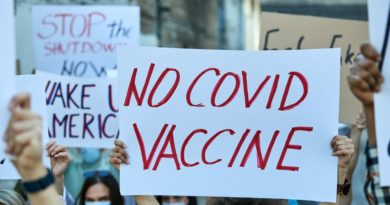China Peddles Falsehoods to Obscure Origin of Covid Pandemic

The mild-mannered German scientist never anticipated becoming a Chinese propaganda star.
But Alexander Kekulé, the director of the Institute for Biosecurity Research in Halle, Germany, has been all over the state-run media in China in recent days. News outlets have taken Dr. Kekulé’s research out of context to suggest that Italy, not China, is where the coronavirus pandemic began. Photos of him have appeared on Chinese news sites under headlines reading, “China is innocent!”
Dr. Kekulé, who has repeatedly said that he believes the virus first emerged in China, was startled. “This is pure propaganda,” he said in an interview.
Facing global anger over their initial mishandling of the outbreak, the Chinese authorities are now trying to rewrite the narrative of the pandemic by pushing theories that the virus originated outside China.
In recent days, Chinese officials have said that packaged food from overseas might have initially brought the virus to China. Scientists have released a paper positing that the pandemic could have started in India. The state news media has published false stories misrepresenting foreign experts, including Dr. Kekulé and officials at the World Health Organization, as having said the coronavirus came from elsewhere.
The campaign seems to reflect anxiety within the ruling Communist Party about the continuing damage to China’s international reputation brought by the pandemic. Western officials have criticized Beijing for trying to conceal the outbreak when it first erupted.
The party also appears eager to muddy the waters as the World Health Organization begins an investigation into the question of how the virus jumped from animals to humans, a critical inquiry that experts say is the best hope to avoid another pandemic. China, which has greatly expanded its influence in the W.H.O. in recent years, has tightly controlled the effort by designating Chinese scientists to lead key parts of the investigation.
By spreading theories that foreigners are responsible for the pandemic, the party is deploying a well-worn playbook. The Chinese government is rarely willing to publicly address its own shortcomings, often preferring to redirect attention elsewhere and rally the country against a common enemy.
China’s leader, Xi Jinping, has led a vigorous effort this year to play down his government’s early failures in the crisis, instead arguing that the party’s success in containing the virus shows the superiority of its authoritarian system.
The latest propaganda push gives Mr. Xi a fresh chance to stoke nationalist sentiment and distract from festering problems, including a lingering wealth gap. The government seems wary of inviting renewed scrutiny of its actions as the pandemic began to unfold, analysts say.
Mr. Xi most likely sees the party’s missteps as a vulnerability and is eager to avoid potential challenges to his authority at home, said Erin Baggott Carter, an assistant professor of political science at the University of Southern California. “If Xi is able to escape blame for the coronavirus, that reduces one major source of discontent with his rule,” she said.
In some ways, China’s strategy resembles efforts by American lawmakers to distract from missteps in that country by spreading fringe theories, including the unsubstantiated notion that the Chinese government manufactured the virus as a biological weapon.
For months, Chinese officials openly spread conspiracy theories of their own, implying at one point that the United States military could have brought the virus to the city of Wuhan. Experts and officials are now going further, trying to give falsehoods about the origins of the virus the veneer of scientific fact.
A recent paper by a group of scientists affiliated with the state-run Chinese Academy of Sciences indicated that the virus could have broken out in India before spreading to China. “Wuhan is not the place where human-to-human SARS-CoV-2 transmission first happened,” said the paper, which appeared last month on SSRN, an online scholarly repository. The paper, which was not peer-reviewed, had been submitted to The Lancet, a medical journal, for publication.
After drawing wide attention in the Chinese news media and in overseas outlets, the 22-page article vanished from online sites. A spokeswoman for The Lancet said it had been removed from SSRN at the request of the paper’s authors. The scientists did not respond to requests for comment.
The article was the latest in a series of comments and articles by Chinese scientists arguing that the virus had first surfaced in Italy, Spain or elsewhere before spreading to China.
While recent studies have indicated that the coronavirus may have infected people in the United States and elsewhere earlier than previously thought, researchers still believe the most likely explanation is that it started circulating in China.
Edward Holmes, a professor at the University of Sydney who has studied the coronavirus, said the idea that the virus originated outside China seemed to be gaining traction for political purposes. “It lacks scientific credibility and will only further fuel the conspiracy theories,” he said.
As part of their efforts to redirect attention toward other countries, Chinese scholars and officials have in recent weeks revived another unproven theory: that frozen food packages from abroad brought the virus to China. Chinese officials say they have detected the virus on pork from Germany, shrimp from Ecuador, salmon from Norway and other products.
While the World Health Organization says the probability of becoming infected from coming into contact with food and food packaging is low, Chinese officials have doubled down on the theory.
“More and more evidence suggests that the frozen seafood or meat products probably spread the virus from countries with the epidemic into our country,” Wu Zunyou, the chief epidemiologist at the Chinese Center for Disease Control and Prevention, said in a recent interview posted on a government website.
Even if the virus could spread through frozen goods, experts say packaged food alone cannot explain why the first major outbreak took place in Wuhan.
As it seeks to push its theories on the global stage, the Chinese government has distorted comments from foreign experts to falsely suggest that there is broad consensus that the virus first surfaced outside China.
Michael Ryan, the World Health Organization’s emergency director, spoke recently about the need for a rigorous investigation into how the virus spread from animals to humans. “We need to start where we found the first cases and that is in Wuhan in China,” Dr. Ryan said at a news conference late last month in Geneva.
But in China, the government framed Dr. Ryan’s remarks differently. The news media falsely claimed that he had said the virus existed around the world but happened to be discovered in Wuhan.
Dr. Ryan was more explicit a few days later, saying the idea that the virus originated outside China was “highly speculative.” Official news outlets in China did not report that remark.
When Dr. Kekulé, the German scientist, appeared on a television news show last month to discuss the pandemic, he made a point of saying that it was clear the virus had first emerged in China. During the interview, he also criticized European officials for taking too long to detect the virus, saying it enabled Covid-19 to spread across the globe.
Chinese news outlets seized on the latter remarks. “He noted that for a global pandemic, the starting shot was fired in northern Italy,” said a report by China Global Television Network, an international arm of the official Chinese state broadcaster.
Dr. Kekulé, who has written a book about the pandemic, was distraught and set out to correct the record, going on German television again to say he had been misquoted.
“China uses everything for propaganda,” Dr. Kekulé said in an interview. “I started to realize that I had to do something about it.”
But Dr. Kekulé’s efforts were largely in vain. Video clips of his remarks about Europe had already spread widely on the Chinese internet. Thousands of people were sharing state media articles about his research, leaving comments such as, “A billion people in China thank you!” and “There are not many scientists who dare tell the truth.”
A simple phrase appeared in red writing above Dr. Kekulé’s face in a meme that circulated online: “Not Wuhan.”
Chris Buckley contributed reporting. Albee Zhang contributed research.
*** This article has been archived for your research. The original version from The New York Times can be found here ***


